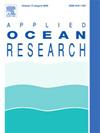带浅滩水槽中横波的数值研究
IF 4.3
2区 工程技术
Q1 ENGINEERING, OCEAN
引用次数: 0
摘要
本研究探讨了水槽中横波的对称和反对称横向模式,尤其侧重于造浪机产生的纵向入射波所诱发的横向模式。模式数最低的主要模式--对称模式(1,0)和反对称模式(1,1)因其能量集中而成为研究重点。我们采用数值模拟来研究它们的发生机制、演变过程和空间模式,以及影响其行为的因素。在实验观测和初步分析解之后,模拟深入研究了这些横向模式的详细行为,并通过与分析解的比较确认了它们的存在和特征。研究表明,微小的扰动,如双曲余弦浅滩上的水面扰动或横坡变化,对激发这些模式至关重要。值得注意的是,虽然对称和反对称横波最初可以被激发,但它们无法保持稳定的形式,而是迅速衰减,这表明它们在水槽环境中具有瞬态性质。入射波高和水深参数对这些波的发展和特征有很大影响,入射波越大,横波的频率和变化就越大。在双曲余弦滩涂上还初步观测到了纵向模式和横向模式之间的相互作用,这与之前的研究结果一致,表明需要进一步研究它们之间的相互作用和能量传递机制。本文章由计算机程序翻译,如有差异,请以英文原文为准。
Numerical investigation of cross waves in water flume with a shoal
This study examines the symmetrical and anti-symmetrical transverse modes of cross waves in a water flume, particularly focusing on those induced by longitudinally incident waves created by a wavemaker. The primary modes with the lowest mode numbers, symmetrical (1,0) and anti-symmetrical (1,1), were the focus due to their significant energy concentration. Numerical simulations were employed to investigate their occurrence mechanism, evolution processes, and spatial patterns, along with the factors influencing their behavior. Following experimental observations and preliminary analytical solutions, the simulations delved into the detailed behavior of these transverse modes, confirming their presence and characteristics through comparison with analytical solutions. The study reveals that minor perturbations, like water surface disturbances or cross slope variations on the hyperbolic cosine shoal, are essential for exciting these modes. Notably, while symmetrical and anti-symmetrical transverse waves can be initially excited, they cannot maintain a steady form and decay rapidly, indicating their transient nature in the flume environment. The incident wave height and bathymetrical parameter significantly influence the development and characteristics of these waves, with larger incident waves promoting more frequent and varied transverse modes. The interaction between longitudinal and transverse modes on the hyperbolic cosine shoal was also preliminarily observed, aligning with previous studies and suggesting a need for further investigation into their interaction and energy transfer mechanisms.
求助全文
通过发布文献求助,成功后即可免费获取论文全文。
去求助
来源期刊

Applied Ocean Research
地学-工程:大洋
CiteScore
8.70
自引率
7.00%
发文量
316
审稿时长
59 days
期刊介绍:
The aim of Applied Ocean Research is to encourage the submission of papers that advance the state of knowledge in a range of topics relevant to ocean engineering.
 求助内容:
求助内容: 应助结果提醒方式:
应助结果提醒方式:


